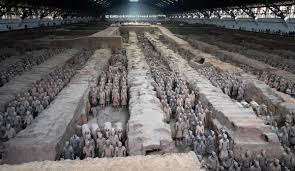
What are the Terracotta Warriors in Pit No. 1?
Pit No. 1, the largest and most impressive of the three pits, is a sight to behold. It houses over 6,000 life-sized terracotta warriors and horses, with only about 1,000 excavated and displayed to the public. Each figure is meticulously crafted with unique facial features, hairstyles, armor, and weaponry, showcasing the artistry and skill of the Qin dynasty craftsmen.
The Scale and Arrangement of Pit No. 1
Imagine a rectangular pit, spanning over 230 meters long, 62 meters wide, and 5 meters deep – that’s the scale of Pit No. 1. This massive underground space is meticulously arranged to resemble a real battle formation.
- Vanguard: At the eastern front, three rows of infantry, armed with bows and crossbows, form the vanguard, ready to engage the enemy.
- Main Force: Following the vanguard, the main force consists of tightly packed columns of infantry and chariots, showcasing the military might of the Qin army.
- Rear Guard: Protecting the rear, the back rows feature high-ranking officers and specialized troops, ensuring the army’s strategic command and control.
- Side Wings: Further enhancing the formation, side wings composed of chariots and cavalry flanks the main force, adding maneuverability and flanking capabilities.
The Realism of the Terracotta Army
The most striking feature of the Terracotta Army is its remarkable realism. Each figure is life-sized, meticulously sculpted with individual facial features, expressions, and hairstyles, making no two soldiers identical.
- Individuality: The artisans paid meticulous attention to detail, crafting each figure with distinct facial features, hairstyles, and expressions, giving them a sense of individuality and life.
- Life-Sized: The figures are life-sized, standing between 1.8 to 1.95 meters tall, further adding to the realism and grandeur of the army.
- Realistic Clothing and Armor: The warriors' clothing and armor are intricately detailed, accurately reflecting the materials and styles of the Qin dynasty.
- Varied Weaponry: The terracotta soldiers are equipped with a variety of weapons, including bronze swords, spears, crossbows, and daggers, demonstrating the diverse arsenal of the Qin army.
- Painted Details: Originally, the figures were vibrantly painted, further enhancing their realism. However, much of the paint has faded over time due to exposure to air and moisture.
Significance and Legacy
The Terracotta Army of Pit No. 1 is more than just a collection of statues; it’s a window into the past, providing valuable insights into the military organization, weaponry, and cultural practices of the Qin dynasty.
- Military Might: The sheer scale and meticulous arrangement of the army highlight the military might and ambition of Qin Shi Huang, the first emperor of China.
- Artistic Achievement: The Terracotta Army stands as a testament to the artistic skill and craftsmanship of the Qin dynasty.
- Historical Insight: The figures, their weapons, and their formation provide invaluable insights into the military organization, weaponry, and cultural practices of ancient China.
Q&A
1. What is the purpose of the Terracotta Army?
The Terracotta Army was designed to protect Emperor Qin Shi Huang in the afterlife, reflecting the ancient Chinese belief in providing provisions and protection for the deceased in their journey to the next world.
2. How were the terracotta figures made?
The figures were created using a complex process involving clay modeling, mold casting, and firing. Different body parts were molded separately and then assembled. Finally, they were fired in kilns at high temperatures.
3. Why is the Terracotta Army significant?
The Terracotta Army is significant for its sheer scale, artistic achievement, and historical value. It provides invaluable insights into the military practices, craftsmanship, and cultural beliefs of the Qin dynasty, offering a glimpse into a pivotal period in Chinese history.